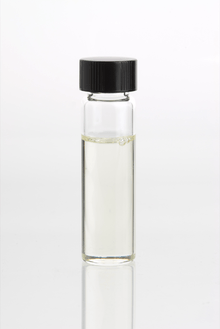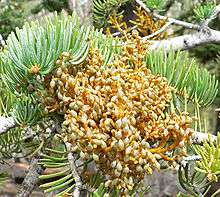Abies concolor
| Abies concolor White fir | |
|---|---|
 | |
| Sierra Nevada white fir in Yosemite National Park | |
| Scientific classification | |
| Kingdom: | Plantae |
| Division: | Pinophyta |
| Class: | Pinopsida |
| Order: | Pinales |
| Family: | Pinaceae |
| Genus: | Abies |
| Species: | A. concolor |
| Binomial name | |
| Abies concolor (Gordon) Lindley ex Hildebrand | |
 | |
| Natural range of var. concolor in green and var. lowiana in blue | |
| Synonyms[2][3] | |
| |
Abies concolor, commonly known as the white fir[4] or Colorado white-fir,[5] is a fir native to the mountains of western North America, occurring at elevations of 900–3,400 m (3,000–11,200 ft). It is a medium to large evergreen coniferous tree growing to 25–60 m (80–195 ft) tall and with a trunk diameter of up to 2 m (6.6 ft). It is popular as an ornamental landscaping tree and as a Christmas tree. It is sometimes called concolor fir.[6]
Description
The leaves are needle-like, flattened, 2.5–6 cm (1–2 3⁄8 in) long and 2 mm (3⁄32 in) wide by 0.5–1 mm (1⁄64–3⁄64 in) thick, green to glaucous blue-green above, and with two glaucous blue-white bands of stomatal bloom below, and slightly notched to bluntly pointed at the tip. The leaf arrangement is spiral on the shoot, but with each leaf variably twisted at the base so they all lie in either two more-or-less flat ranks on either side of the shoot, or upswept across the top of the shoot but not below the shoot.
The cones are 6–12 cm (2 1⁄4–4 3⁄4 in) long and 4–4.5 cm (1 5⁄8–1 3⁄4 in) broad, green or purple ripening pale brown, with about 100–150 scales; the scale bracts are short, and hidden in the closed cone. The winged seeds are released when the cones disintegrate at maturity about 6 months after pollination.[7]
Subspecies

As treated here, there are two subspecies; these are also variously treated at either the lower rank of variety by some authors, or as distinct species by others:
Abies concolor subsp. concolor
- Abies concolor subsp. concolor — Colorado white fir or Rocky Mountains white fir. In the United States, at altitudes of 1,700–3,400 m (5,600–11,200 ft) in the Rocky Mountains from southern Idaho, south through Utah and Colorado, to New Mexico and Arizona, and on the higher Great Basin mountains of Nevada and extreme southeastern California, and a short distance into northern Sonora, Mexico. A smaller tree to 25–35 m (80–115 ft) tall, rarely 45 m (150 ft). Foliage strongly upcurved to erect on all except weak shaded shoots in the lower crown; leaves mostly 3.5–6 cm (1 3⁄8–2 3⁄8 in), and strongly glaucous on the upper side with numerous stomata. Tolerates winter temperatures down to about −40 °C (−40 °F).
Abies concolor subsp. lowiana
- Abies concolor subsp. lowiana (syn. Abies lowiana) — Low's white fir or Sierra Nevada white fir. In the United States, at altitudes of 900–2,700 m (3,000–8,900 ft) from the Cascades of central Oregon south through California (Klamath Mountains, Sierra Nevada) to northern Baja California, Mexico. A larger tree to 40–60 m (130–195 ft) tall. Foliage flattened on lower crown shoots, the leaves often raised above the shoot on upper crown shoots but not often strongly upcurved; leaves mostly 2.5–5 cm (1–2 in), and only weakly glaucous on the upper side with few or no stomata. Tolerates winter temperatures down to about −30 °C (−22 °F).
Related species
White fir is very closely related to grand fir (Abies grandis), with subspecies lowiana being particularly similar to the interior variety of grand fir A. grandis var. idahoensis, intergrading with it where they meet in the Cascades of central Oregon. To the south in Mexico, it is replaced by further close relatives, Durango fir (A. durangensis) and Mexican fir (A. mexicana). ...
Forest succession
White fir, being shade tolerant, is a climax species in forest succession in the Sierra Nevada, and in the presence of modern human controls against forest fires, it has flourished over the past two centuries. It is sometimes regarded as a pest by those in the lumber industry, as it drives out trees of greater stature (such as the sugar pine and incense cedar), has weaker, knottier wood than its competitors, and retains its lower limbs. This latter trait creates a fire ladder that allows flames to reach up to the canopy, thinning out giant sequoia stands that would escape smaller forest fires with minimal damage.[8]
Discovery
This tree was discovered by William Lobb on his expedition to California of 1849–1853, having been overlooked previously by David Douglas.[9][10][11]
Ecology
This tree is host to fir mistletoe (Phoradendron pauciflorum), a parasitic plant. It is attacked by many types of insects, such as the fir engraver (Scolytus ventralis).[12]
Uses

White fir is a preferred construction species because of its nail-holding ability, lightness in weight, and resistance to split, twist, and pitch. It is straight-grained, non-resinous, fine-textured, stiff, and strong.[13]
White fir is popular as a Christmas tree and for Christmas decoration owing to its soft needles, generally excellent needle retention and abundance. It is often marketed as concolor or white fir.[14]
Cultivation
White fir is widely planted as an ornamental tree in parks and larger gardens, particularly some cultivars of subsp. concolor selected for very bright glaucous blue foliage, such as cv. 'Violacea'. The cultivar 'Compacta' has gained the Royal Horticultural Society's Award of Garden Merit.[15]
Gallery
-

A. concolor subsp. lowiana foliage upperside
-

A. concolor subsp. lowiana foliage underside
-

A young sapling of subsp. lowiana on Mount Whitney
-
White fir in garden environment at Minnesota Landscape Arboretum
-

Small stand of young white firs on Cuyamaca Peak California
-

White firs at Toro Peak, CA.
-

White fir next to ponderosa pine on Toro Peak
-

Foliage, with Arceuthobium abietinum infestation
References
- ↑ Farjon, A. (2013). "Abies concolor". IUCN Red List of Threatened Species. Version 2013.2. International Union for Conservation of Nature. Retrieved 2 May 2014.
- ↑ Tropicos
- ↑ The Plant List
- ↑ "Abies concolor". Natural Resources Conservation Service PLANTS Database. USDA. Retrieved 6 January 2016.
- ↑ "BSBI List 2007" (xls). Botanical Society of Britain and Ireland. Archived from the original on 2015-02-25. Retrieved 2014-10-17.
- ↑ "Concolor Fir (White Fir)". National Christmas Tree Association.
- ↑ "Abies concolor". Flora of North America (FNA). Missouri Botanical Garden – via eFloras.org.
- ↑ The Giant Sequoia of the Sierra Nevada Archived October 22, 2012, at the Wayback Machine.
- ↑ Toby Musgrave; Chris Gardner & Will Musgrave (1999). The Plant Hunters. Seven Dials. p. 147. ISBN 1-84188-001-9.
- ↑ Hildebrand, Friedrich Hermann Gustav. Verhandlungen des Naturhistorischen Vereines der Preussischen Rheinlande und Westphalens 18: 261. 1861.
- ↑ Gordon, George, & Glendinning, Robert. Pinetum 155. 1858.
- ↑ Maloney P. E. & D. M. Rizzo. (2002). Pathogens and insects in a pristine forest ecosystem: the Sierra San Pedro Martir, Baja, Mexico. Canadian Journal of Forest Research 32:3 448-57.
- ↑ Western Wood Products Association (WWPA)
- ↑ Christmas Tree Types Archived January 16, 2009, at the Wayback Machine.
- ↑ RHS Plant Selector Abies concolor 'Compacta' AGM / RHS Gardening
Further reading
- Chase, J. Smeaton (1911). Cone-bearing Trees of the California Mountains. Chicago: A. C. McClurg & Co. p. 99. LCCN 11004975. OCLC 3477527. LCC QK495.C75 C4, with illustrations by Carl Eytel - Kurut, Gary F. (2009), "Carl Eytel: Southern California Desert Artist", California State Library Foundation, Bulletin No. 95, pp. 17-20 retrieved November 13, 2011
- Farjon, A. (2013). "Abies concolor". IUCN Red List of Threatened Species. Version 2013.2. International Union for Conservation of Nature. Retrieved 2 May 2014.
- Laacke, Robert J. (1990). "Abies concolor". In Burns, Russell M.; Honkala, Barbara H. Conifers. Silvics of North America. Washington, D.C.: United States Forest Service (USFS), United States Department of Agriculture (USDA). 1 – via Northeastern Area State and Private Forestry (www.na.fs.fed.us).
External links
| Wikimedia Commons has media related to Abies concolor (White Fir). |
- Jepson Manuel Treatment: Abies concolor
- Gymnosperm Database: Abies concolor — (treated as varieties of one species).
- Flora of North America - treated as two species:
- Abies concolor and :Abies lowiana .
- Interactive Distribution Map of Abies concolor
- USDA Plants Profile for Abies concolor (white fir)
- Conifers Around the World: Abies concolor - Rocky Mountain White Fir.
